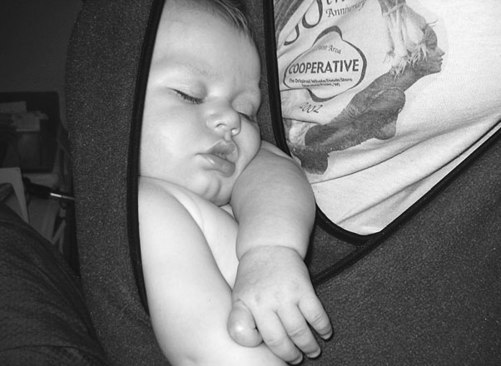The No Cry Nap Solution (29 page)
Read The No Cry Nap Solution Online
Authors: Elizabeth Pantley
guidance. Or check out one of the many wonderful classes or
books on baby massage.
Move Your Sleeping Baby
If your baby will not fall asleep in the crib but falls deeply asleep in
the swing, try letting her fall asleep in the swing and then move
her while she sleeps. Set up her bedroom to be inviting for sleep:
pull down the shades, turn on soft music or white noise, and warm
up the sheets with a heat pack or warm towel (remove these before
you lay your baby down). It can help to locate the swing in the
bedroom next to the crib so that you aren’t traveling a long dis-
tance between the two places.
Swinging, Bouncing, Vibrating, or Gliding
183
As soon as she is asleep, carefully transfer her to the bed. Make
your movements slow but steady. You might also try the Pantley
Dance, as described starting on page 144.
If your baby wakes the minute she touches the crib, try putting
a travel cradle or Moses basket in the crib to make it a smaller
space, or add a soft mattress pad under fl annel sheets. For more
ideas on how to make the crib cozy, see page 140.
Any time you change what you are doing at naptime, your
baby may resist the idea. Stay with any new idea for a few
weeks to allow your baby to adjust before you judge its true
effectiveness.
Night Sleep in the Crib, but Day Sleep in
a Swing?
A surprising number of parents report that their baby sleeps fi ne
at night in the crib, cradle, or bed but won’t nap there during the
day. For daytime naps they must turn to motion sleep. There are
three main reasons this happens: your night routine is more spe-
cifi c than your nap routine, you are misreading your baby’s tired
signs and attempting naps at times when your baby is not sleepy or
is extremely overtired, or you co-sleep with your baby, which is an
acceptable alternative for most children.
If your baby takes to the crib at night but not for naps, the
fi rst step is to take a look at your successful bedtime routine and
re-create it for naptime. You may not realize the many subtle dif-
ferences between the two until you act them out. The easiest way
to do this is to simply fool yourself and your baby into thinking it
184 Solving Napping Problems
is bedtime. Do exactly what you do in the evening—even though
it’s really noon!
The second thing to watch is the span of wakeful time between
sleep sessions. Be sure your baby has been awake long enough,
yet not too long, by naptime. Check the chart on page 8 and also
watch your baby for some of the tired signs listed on pages 44
and 88.
Keep Trying!
If your baby totally resists all attempts you make to have her nap
in her crib, then sometimes it’s best to leave well enough alone
for a week or two or even longer. Then try again, perhaps with a
different plan. Sometimes a slight change to your approach along
with a few weeks of maturity can make a big difference in the end
result. All babies eventually outgrow the need for motion during
naptime.


Helping Your Newborn Tummy
Sleeper Go “Back to Sleep”
I know that my newborn should sleep on
her back, but she hates it! When I let her
sleep on her tummy, she naps longer and
better, so I’m tempted to let her sleep
that way. Would that be a good idea?
When you’ve found a way to help your baby sleep better, it is
tempting to give in, no matter what. However, when your
baby’s safety is at risk, it’s not worth the few hours of sleep you’ll
gain. Studies have proved scientifi cally that back sleeping is the
safest way for babies to sleep, due to the higher risk of sudden
infant death syndrome (SIDS) when stomach sleeping. SIDS is not
totally preventable, nor can it be diagnosed before it occurs, but
this is one factor that parents can control. In most cases, infants
who sleep on their backs are less susceptible to SIDS than those
who sleep on their stomachs.
This isn’t an issue you’ll need to deal with forever, as your baby
will (far too soon) grow out of the newborn stage. There isn’t
an exact age when belly sleeping becomes a safe position; this is
unique to every child. However, most specialists imply that once
your baby can hold her head up steadily and roll easily from belly
to back and back to belly, you can put her to sleep on her back and
then let her fi nd her own comfortable position.
Once your doctor confi rms that back sleeping is best for your
baby, always put her to sleep on her back. If your little one resists
this sleep position, try the following ideas to encourage back
sleeping.
185
186 Solving Napping Problems
Investigate Using an Infant Sleep-
Positioning System
There are a wide variety of infant sleep-positioning systems on
the market. These are often made of foam and have two side bol-
sters (round or triangular) connected by a bottom piece of fab-
ric. At this time, none of these carry a recommendation or stamp
of approval by any medical group, as more research needs to be
completed on the safety of these products. Nonetheless, they are
becoming very popular and are even recommended by some pedi-
atricians. The designs are constantly improving, so search around
for the best one you can fi nd.
Many parents use positioners successfully for babies who resist
back sleeping or who have refl ux or other digestive problems. Many
say that when they fi rmly swaddle their baby and place him on his
back in a properly fi tting positioner, it solves many sleep problems.
Ask around and search the Internet for parent recommendations
on these, and talk with your medical professional about using one
for your baby.
When your baby can roll from back to front and front to back,
it’s time to stop using a positioner. If your baby rebels at fi rst, you
can remove one side of the positioner. Also, increase the number
of tummy-time fl oor-practice sessions throughout each day to help
your baby practice this new rolling skill. Within a few weeks, your
baby will have mastered this maneuver and will be more comfort-
able in his crib.
Use a Crib Alternative for Naps
Sleeping in a sling, stroller, swing, or infant seat will keep your
baby slightly curled, rather than fl at on a mattress. Many tummy
sleepers enjoy the curved position much more than lying fl at on
their backs. In addition, these carriers have a more fl exible, softer
surface that invites sleep. Be sure to follow safety precautions and

Helping Your Newborn Tummy Sleeper Go “Back to Sleep”
187
Luca Eamon, seven months old, in Mama’s sling
read the instructions that come with the device. Manufacturers
of car seats, strollers, and infant seats warn parents not to leave
a baby alone in these seats, so this idea works only when you are
awake and close by for naps; they aren’t good places for night sleep.
Keep an eye on your baby and watch to be sure he doesn’t twist
around in the seat, become entangled in the straps, or hunch too
far forward, as this can interfere with proper breathing.
While a car seat creates a nice nest for sleeping, new studies tell
us that babies should not be left to sleep for long spans in a car
seat because the positioning can also interfere with proper breath-
ing. There are a number of positioning cushions that can be used
in a car seat or baby seat to hold your baby’s upper body in a safer
sleep position. These typically have a pad that is placed under the
baby’s back with side “wings” to prevent a baby’s head from wob-
bling. New designs of some car seats allow them to adjust to lie fl at
when taken out of the car. If your baby often falls asleep in the car
seat, it would be worth it to check out a seat of this style.
188 Solving Napping Problems
While all of these alternative places may help your baby nap
better, there will soon come a time when you would like the free-
dom of putting your baby down for a nap in a bed and taking some
baby-free time while he sleeps. Even though you’ll likely have to
help your baby adjust to the change at some point, the vast major-
ity of parents feel it is still worth it to use these nestlike places to
improve their newborn’s sleep.
When it’s time to help your baby make the transition to a fl at
crib, try moving him after he is asleep. Or you can pat or rub your
baby’s tummy, legs, or head at the transition to be sure he stays
asleep. Or use the Pantley Dance transfer method described on
page 144. You can also put him in a rocking cradle, which makes
up for the fl at surface with gentle movement. For more ideas on
weaning to a crib for naps, see the chapter “Swinging, Bouncing,
Vibrating, or Gliding: Making the Transition from Motion Sleep
to Stationary Sleep.”
Use a Baby Hammock
Babies who resist lying on their backs on a traditional mattress
will often welcome back sleeping in a baby hammock. These
safely cradle your baby in a comforting fetal position. Hammocks
provide a more fl exible, yielding surface and provide soothing
sleep-inducing movement, as well. A baby hammock is especially
helpful if your baby is a preemie, a restless sleeper, or a short nap-
per or if he has colic, refl ux, allergies, or any other health issues.
Shop around to fi nd a model that suits you and your baby.
Try Swaddling Your Baby for Naps
Very often a baby who resists sleeping on her back fi nds the posi-
tion diffi cult because of her natural startle refl exes. When her arms
or legs move in ways that she can’t easily control, this prevents her
from sleeping or startles her awake. Being swaddled prevents her
Helping Your Newborn Tummy Sleeper Go “Back to Sleep”
189
natural refl exes from waking her up. (For more about swaddling,
see the chapter “How to Use Swaddling for Naptime.”)
Warm Up Your Baby’s Sleeping Surface
Some babies may not actually object to back sleeping but to the
transition from your warm arms to a cold bed. You can place a
heating pad set on the lowest setting or a bead-fi lled warmer on
your baby’s mattress just before naptime. Remove the heat source
and rub your arm over the surface to be sure it is not too hot for